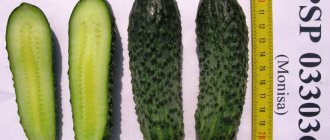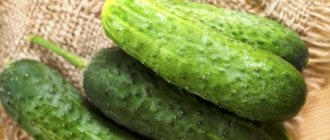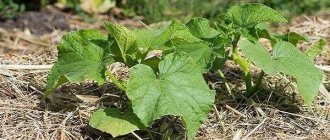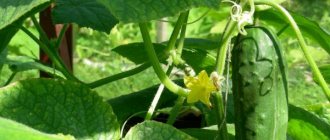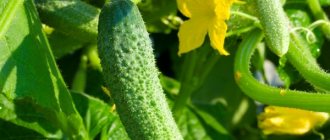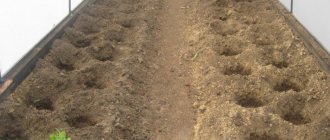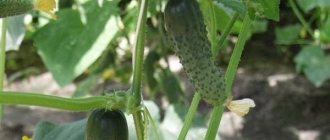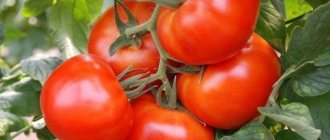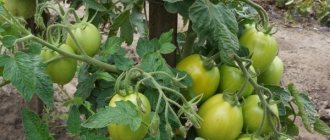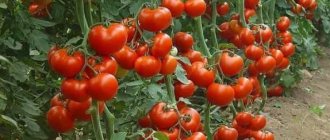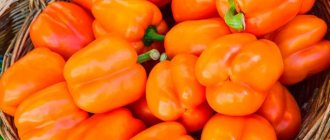The classic appearance of the fruit, excellent taste and canning properties make this cucumber a leader among early ripening species. Grasshopper f1 is an indeterminate hybrid with high productivity and disease resistance, which is adapted to various conditions.
| Landing location | Ripening time | Mode of application | Fruit length | Group | Fruit smoothness | Pollination method |
| Universal | Early ripening (35-45 days) | Universal | Medium - from 10 to 15 cm | Hybrid | Highly lumpy | Parthenocarpic |
Characteristics and description of the variety
The Grasshopper cucumber is not a variety in the full sense of the word, it belongs to hybrids and must be accompanied by the F1 icon, indicating that it belongs to a first generation hybrid.
The hybrid was obtained by Russian agricultural breeders from the city of Mytishchi, located in the Moscow region.
The main purpose of these cucumbers is early consumption, so such properties of the vegetable as early fruiting, high yield and marketable appearance of the fruit are important.
This is a very important quality when selling cucumbers at the highest price.
The stable yield of this cucumber is explained by its parthenocarpic nature: all flowers on the plant are female and do not require additional pollination by bees or other insects. This hybrid can be grown both in a greenhouse and in open ground.
Grasshopper F1 is a vegetable with an early ripening period: the first cucumbers can be removed from the bush within 40 days after the seedlings appear on the surface of the soil.
Appearance of the bush
The main stem of the hybrid Grasshopper F1 is not too long and rarely exceeds 2 m. The length of the main stem of the vegetable depends on the growing conditions of the hybrid. Outdoors, the stem will be up to 1.5 m long, and in a heated greenhouse it will reach 2 m.
Did you know? Scientists on the International Space Station grew cucumbers in space to determine which factor had the greatest influence on root development (water or gravity). The palm went to water.
The lateral stems are located on the main stem through 1–2 leaves and develop in the axils located between the leaf and the main stem. The length of the side stems can reach 1.2 m. When forming a cucumber bush, gardeners usually cut the side shoots into 3–4 leaves or 20–30 cm in length.
The bush has good foliage. The leaves of this hybrid are wide, fleshy, consist of 5 segments, bright green, soft and rough.
Features of the fruit
Hybrid Grasshopper F1 belongs to the bunched variety of cucumbers, i.e. the fruits are set in the axil of the leaf not one or two at a time, but in a bunch consisting of 2–6 ovaries. Cucumbers in a bunch are poured and ripened not simultaneously, but sequentially, one after another.
The fruits of Grasshopper F1 are neat, small, cylindrical. The color of cucumbers is dark green, the skin is slightly lumpy, the shape of the cucumber has distinct longitudinal edges. Ripe fruits have small whitish spines.
The weight of an adult cucumber does not exceed 90–100 g, the maximum length of the fruit is 12 cm, the diameter is 3.5 cm. Young fruits are juicy, crispy, tasty and aromatic. Zelentsy are covered with delicate skin. It is recommended to collect the fruits of Grasshopper F1 when they reach a length of 6–7 cm. Overripe cucumbers are prone to the formation of voids inside the fruit.
Fruitfulness
To get a good profit from the sale of cucumber fruits, the vegetable grower must ensure very early planting. To do this, this hybrid is grown using seedlings, which after 30 days are planted in well-fertilized soil of a heated greenhouse. The yield of the hybrid is very high: in a greenhouse with an area of 10 m², with the right agricultural technology, you can get a harvest of up to 140 kg of cucumbers. It takes 38-39 days from full germination to fruiting.
Did you know? Tiberius, the ancient Roman emperor, was very fond of cucumbers and wanted to eat these vegetables all year round: both winter and summer. The imperial desire was the impetus for the creation of the world's first greenhouses by palace gardeners.
History of the variety's creation
This cucumber hybrid was bred by breeders from a seed production plant located in the city of Mytishchi at the very end of the last century. The cucumber Grasshopper f1 underwent variety testing at various experimental sites in the country, and in 2004 this hybrid was included in the Russian State Register.
Cucumber Grasshopper f1 is recommended for growing in garden beds in open ground and in greenhouse conditions in many Russian regions.
Photo of cucumber Grasshopper f1
Pros and cons of the variety
Like many other hybrids, Grasshopper F1 differs from ordinary cucumber varieties in its excellent yield. In addition, it is characterized by increased multiple births due to the formation of a fascicular ovary. Cucumbers are a low-calorie vegetable: 100 g of cucumber pulp contains only 30 calories.
- Positive aspects of the hybrid:
- excellent yield;
- rapid fruit ripening;
- presentation of cucumbers;
- good taste;
- absence of bitterness gene in fruits;
- suitability for preservation and salting;
- long and gradual fruiting;
- lack of tendency to outgrow.
The only negative side of the hybrid is its unsuitability for collecting seeds for subsequent propagation.
Diseases and pests
Like most other cucumber hybrids, Grasshopper has fairly good immunity, so this variety is practically not affected by the following diseases:
- olive spot;
- cucumber mosaic virus;
- powdery mildew.
This hybrid has average resistance to peronosporosis. This disease can be provoked by: cold summer, watering with cold water, highly acidified soil.
Photo of downy mildew on cucumber leaves
For preventive purposes, it is recommended to spray with Profmiptom, Fitosporin or Ridomil.
If downy mildew has already appeared on cucumber vines, it is recommended to wash them with soap or mustard solution, or use systemic fungicidal preparations.
Sowing and growing technology
Cucumbers can be sown either directly in open ground or planted as seedlings in a garden bed. To obtain very early production, it is advisable to first grow seedlings.
You can calculate the time for sowing cucumber seeds for seedlings as follows: count back 35 days from the expected date of planting the seedlings in the ground. This will be the optimal date for sowing seeds for seedlings. It is not recommended to sow the seeds too early as the plants should not outgrow the containers.
How to properly grow cucumber seedlings:
- Seeds are sown in planting containers with a volume of at least 0.5 liters per plant. Pots for growing seedlings must have holes in the bottom to drain excess moisture. If the pots do not have drainage holes, the cucumber's root system will most likely rot and the plant will become sick.
- Pre-mix a soil mixture consisting of equal parts of chernozem, humus and sand. It is also advisable to add a few handfuls of wood ash to the soil mixture. The finished soil must be disinfected from pathogenic microorganisms, eggs and larvae of pests. This can be done in two ways: pour boiling water over the soil or heat it in the oven for 20–30 minutes.
- Disinfected soil is poured into pots so that almost 50% of the free space remains to the edge of the container. During the process of growing seedlings, soil will be poured under the root of the plant, thereby promoting the growth of a well-developed root system.
- Place 2 or 3 seeds in each container to a depth of 1 cm and cover tightly with soil.
- After sowing, water the soil in the pots well with warm water, wait until excess moisture drains through the hole in the bottom of the container, and cover the pot with transparent plastic film.
- Containers with crops are installed in a room where the temperature does not fall below +20°C. High temperatures promote rapid seed germination and seedling development. If all the seeds in the pot have sprouted, only the strongest plant is left for further growth; the remaining sprouts are cut out at soil level using sharp nail scissors.
- As soon as the sprouts appear on the surface of the soil, the containers are moved closer to the light source. This can be either the window sill of a south window or a special seedling table equipped with a lamp for illuminating plants. Do not remove the transparent polyethylene from containers in which sprouts have appeared for another 5–7 days. The film does not allow moisture to evaporate from the soil, thereby reducing the need for young plants to water. Every day, the vegetable grower must remove the plastic film from the pot for 30 minutes to ventilate the seedlings.
- Water the seedlings as needed, when the top layer of soil in the pot dries to a depth of 2 cm. Only warm water is used for watering. It is optimal to water cucumbers with melt or rain water. If chlorinated tap water is used, it must first be left standing for several days.
- 15 days after the sprouts appear, it is necessary to begin hardening the young cucumber seedlings. In the first week of hardening, open a window in the room for 30–40 minutes, increasing the duration of the procedure every day. At the age of 25 days, seedlings begin to be taken outside for hardening and adaptation. Outdoor hardening is carried out at an air temperature of at least +20°C. Outdoors, seedlings are planted in diffuse shade under trees, since direct sunlight can damage delicate plants. On the first day of outdoor hardening, the seedlings remain outdoors for an hour. Every day the duration of outdoor hardening increases until it reaches daylight hours.
- It is optimal to plant cucumber seedlings in a permanent place at an age not exceeding 30 days. Cucumber seedlings are planted in the soil without removing the soil ball from the container, so it is best to use peat pots as containers for growing cucumbers.
Cucumbers are most often sown in open ground by seeds, but adult seedlings can also be planted.
Sowing seeds into the soil:
- Seeds are sown in a pre-prepared bed (filled with organic matter and dug up). With a bed width of 1.2 m, you can sow cucumbers in two parallel rows. In this case, the distance between the rows should be at least 60 cm, and the distance between plants - 20–30 cm. With a bed width of 50–60 cm, cucumbers are sown in one row, with a distance between plants of 15–20 cm.
- Before sowing, the location of future rows is marked and furrows are made for sowing. The depth of the sowing furrows should not exceed 3–5 cm. Water the furrows, wait for the moisture to go into the soil, and only then begin to lay out the cucumber seeds.
- If the gardener wants to speed up the germination process, the seeds are pre-soaked for a day in a damp woolen cloth, and then placed in a plastic bag with wet sawdust. The bag with germinating seeds is placed in a warm place for 2–3 days, until sprouts and roots appear.
The sprouted seeds are placed carefully in the planting furrows, taking care not to damage the roots and sprouts.
- The seeds in the furrows are covered with soil, the soil layer is leveled, after which the crops are watered and covered with agrofibre. Non-woven material helps retain moisture in the soil and reduces the need to water crops.
Did you know? Cucumbers are a fast-growing crop, but various stresses during the growing season can result in the appearance of bitterness in the fruit. Stressful situations include a sharp drop in temperature, lack of moisture and poor soil.
Growing on site
Cucumbers are sown in open ground when the weather is consistently warm. In central Russia, the time for sowing cucumbers falls on May 10–15; in the south, sowing is carried out much earlier - at the end of April. This crop is sown later in the northern regions, where sowing occurs in the first days of June.
Growing cucumbers in open ground is not difficult. But to obtain high yields, the gardener must first prepare the soil in the garden bed intended for growing this crop. First of all, you need to fill the bed with organic matter. Cucumbers are very fond of nitrogen fertilizers, so they are usually fertilized with cattle manure or bird droppings.
Fresh, unrotted manure is best suited for cucumbers. Organic matter is laid out in an equal layer around the perimeter of the intended bed. To fertilize 1 m² of cucumber bed, 1 bucket of manure is enough. Next, the fertilizer spread on the surface is embedded deep into the soil. To do this, dig up the bed with a bayonet shovel with a revolution of the formation.
The surface of the dug bed is leveled with a rake so that a small depression is formed in the center, parallel to the longitudinal edges of the bed. It is in it that a furrow should be made for sowing seeds or holes for planting seedlings. The longitudinal depression will retain moisture at the roots and will not allow water to spread when watering the cucumbers.
Stepping back 10–15 cm, a trellis is installed along the planting furrow for future staking of plants. The trellis can be made of metal or wood, its height varies from 1.5 to 2 m.
As they grow, young plants are tied to the trellis with paper twine or soft cloth. If the cucumber vines outgrow the height of the trellis, the gardener throws them to the opposite side of the trellis and directs the growth towards the ground.
Growing in a greenhouse
A greenhouse and a greenhouse are different, although early cucumbers can be grown in both buildings. The greenhouse is heated using a stove, gas or water heating, and in a greenhouse heat is generated naturally and depends only on the quality of the arrangement of this structure. Greenhouses are usually established when it is not possible to heat high greenhouses, and there is a need for early receipt of products.
Did you know? The practice of growing cucumbers by humans began approximately 4 thousand years ago. In ancient times, cucumbers were not only eaten, but also used to treat the sick, and were also used to whiten the skin.
When setting up a greenhouse, a hole at least 1 m deep is dug around the perimeter of the future building. Fresh horse manure is placed at the bottom of the hole under the greenhouse in a layer of 25–30 cm, and the same layer of plant residues (branches, leaves, straw) is placed on top of it. This entire “sandwich” is covered with a layer of fertile soil 30 cm thick. When the soil for the greenhouse is ready, the greenhouse frame itself is installed on top.
Usually the greenhouse is low, no higher than 80 cm in height, so its space heats up quickly. The greenhouse lid is made of transparent materials (polyethylene, plastic or glass), which provides lighting for the cucumbers and additional heating of the greenhouse with sunlight.
Two weeks before sowing seeds or planting seedlings, the greenhouse is watered generously with hot water at the rate of 10 liters of boiling water per 1 m² of soil. This procedure is needed to heat up the organic matter in the lower layer under the greenhouse.
After watering with boiling water, the greenhouse is tightly closed. As organic fertilizers warm up, they gradually gain a high temperature and heat the top soil layer in the greenhouse to a warm state. The entire structure is heated by the hot soil.
Read more
How to properly grow cucumbers in a greenhouse While it is cold outside, the plants grow in a closed greenhouse.
With the onset of warmth, the gardener begins to ventilate the greenhouse, opening the greenhouse frame slightly (by 10 cm) every day.
Ventilation is necessary because it is hot and humid inside the greenhouse, which can cause fungal diseases.
When the air temperature outside during the day reaches +18…+20°C, the greenhouse frame is opened completely. The greenhouse frame remains in the closed position all daylight hours; it is closed only at night. From about mid-May, depending on the weather, the gardener stops closing the greenhouse both day and night.
By this time, the cucumbers have already reached the height of the structure, so they need support. As a support for cucumbers, you can install a tall wooden peg individually near each plant, or you can take care of constructing a common wooden or metal trellis. Further care for cucumbers in a greenhouse is no different from caring for a crop in open ground.
Landing
For faster ripening of cucumbers, seeds are sown in April for seedlings. Grown under the following conditions:
- illumination of at least 15 hours;
- humidity up to 90%;
- temperature after germination of seedlings is 20-22 degrees.
Seedlings are transplanted to a permanent place if the plants have 3-4 leaves. The bushes do not thicken (for a tall hybrid), they maintain a distance of 30-35 cm.
Seeds should be planted directly into the ground at the end of May, beginning of June.
Rules of care
During the growing season, cucumbers require constant attention and care from the gardener. They need proper bush formation, timely irrigation and fertilizing, mulching, staking, protection from diseases and harmful insects.
Irrigation and fertilization scheme
Cucumbers are famous “water drinkers” and constantly need slightly moist soil. But at the same time, the crop is afraid of moisture getting on the leaves, which can cause an outbreak of diseases. That is why the crop is watered only at the root, without using leaf irrigation.
Find out how to properly water cucumbers in a greenhouse and in open ground.
In the middle zone, cucumbers are watered 2 times a week, pouring at least 3 liters of warm water under the root of one plant. Watering of plants is carried out only in the morning; in any case, irrigation should be completed before noon.
This is due to the fact that drops of water that fall on the cucumber leaves and stems must dry before evening. Otherwise, they will provoke the development of fungal spores and plant disease.
It is very convenient to supply moisture to cucumber roots using drip irrigation.
Irrigation can be combined with plant nutrition. During the growing season, cucumbers are fed several times, with breaks of 10–14 days. The most saturated with nitrogen is liquid root dressing made from fermented bird droppings. This fertilizing must be prepared in advance and used throughout the summer.
Preparing bird droppings:
- A large tank, installed in a place protected from cold winds and well lit by the sun, is filled to half with fresh or dry bird droppings. The droppings of chickens, geese, ducks, and pigeons are suitable for these purposes.
- Next, the tank is filled with water, without adding 20 cm to the edge of the container. This free space is needed so that during fermentation the fertilizing does not spill onto the ground.
- The tank is covered with a lid so that nitrogen from the liquid fertilizer does not erode during fermentation.
- Every day, the contents of the tank are thoroughly mixed using a long wooden stick. This is necessary so that carbon dioxide leaves the solution.
- Depending on the outside air temperature, after 7–12 days the fermentation in the tank will calm down, which means the concentrated fertilizing is ready.
The vegetable grower needs to remember that liquid fertilizer based on bird droppings is a concentrated fertilizer and needs to be diluted with water. Immediately before starting fertilizing, add 0.5 liters of concentrate to each bucket of clean water and use it for its intended purpose.
Bush formation
In order for the hybrid to bear fruit well, the formation of the bush should not be left to chance. The main harvest on the cucumber hybrid Grasshopper F1 is formed on the side stems, therefore, when forming the crop load on the plant, the vegetable grower leaves 2-3 bunches of ovary on each side stem, after which he pinches the side stem.
This formation of the plant is carried out to the top of the greenhouse or trellis. The growth point of the main stem, which has reached the upper limit of growth, is pinched or its lash is directed towards the soil (down).
The best varieties of cucumbers - imported seeds
Note: All photos can be enlarged. Click and read the manufacturer’s recommendations, the main qualities of the variety on the label.
Cucumber Herman F1
This hybrid Herman cucumber is counterfeited more often than others, which is the best proof of its popularity. Genuine cucumber seeds must be expensive and green in color. If you planted Herman and were disappointed, it was not the real Herman. Genuine is always successful.
Cucumber Herman F1 was created by the Dutch company Royal Slice, part of the Seminis concern, which recently merged with the global corporation Monsanto. The cucumber packages may bear the name of one of these brands. The year of registration in the Russian seed register is 2001.
Herman cucumber is a parthenocarpic variety. It is distinguished by its versatility - that is, it is suitable for any climate and microclimate. An early variety and bears fruit for a long time, sometimes earlier than the stated 38 days. The resistance of vegetables to powdery mildew, mosaic, and cladosporiosis is officially declared. In reality, it ignores downy mildew and has a certain resistance to root rot. The growth of the Herman cucumber bush can be described as average. The ovary is bundled (up to 7 pieces). Simultaneous filling of fruits is observed - one at a time in several nodes. After harvesting, the next day, new greens grow in the same nodes.
Cucumbers have an excellent presentation: dark, shiny. White-spined tubercles are usually medium in size. The weight of each cucumber is about 80 grams, the length is up to 10 cm. The preserved pulp is dense and crispy. There is never bitterness.
Cucumber Masha F1
In the state register since 2000. The manufacturer is the same as that of the German cucumber, to which the Masha cucumber is similar in many respects. The differences are manifested in appearance: Masha’s cucumbers are several millimeters thicker and shorter, the tubercles are spaced out less frequently, and the light stripes are more pronounced. The branching of the plant bush is more moderate, the foliage is slightly smaller.
Cucumber Marinda F1
The Marinda F1 cucumber was declared in the Russian registry almost a quarter of a century ago. Still popular, although there are also fakes. Self-pollinating variety. The harvest begins 40 days after germination. The plant is stress-resistant, with strong growth, not many leaves. Five or even more embryos can form in one node. The cucumber greens are dense, not thick, the length varies about 10 cm. The tubercles are quite large, slightly prickly, and white-thorned. There is no bitter taste observed. Marinda cucumber is very good when pickled.
Cucumber Zena F1
Salad-type parthenocarpic with smooth skin. This is a selection of the French branch of the Japanese corporation Sakata, and the seeds are produced in Chile. In the Russian register since 2009. This is a great representative for growing in the south in open ground. The Zena cucumber is the result of targeted selection for heat tolerance.
Ripening period is early. Cucumber bushes are characterized by long-term growth; the side branches are not too long. Vegetable fruits reach a weight of 115-135 grams and a length of up to 16 cm. The plants do not suffer from powdery mildew, as well as downy mildew, and are resistant to viruses. Seeds must be treated against diseases with pesticides, such as thiram.
Cucumber Slice King F1
Another salad hybrid from Sakata, entered into the Russian register in 2009. This type of cucumber is called a slicer - an American salad cucumber. Slice King (“Salad King”) grows outdoors, but requires pollinating insects. There are few male flowers. Increases yield when planting several non-hybrid varieties with male flowers. It is pleased with its early period of fruiting (from 37 days) and high resistance to infections.
The fruit of the vegetable slows down in growth only when it reaches a length of 20 cm. It is covered with sparse small tubercles, on which we will see light pubescence. Weight can reach a quarter of a kilogram. The type of greens, tenderness of taste and aroma are reminiscent of our old popular hybrid of the Timiryazev Academy - Zozulya. It does not turn yellow for a long time and does not become flabby for a long time after harvesting. The taste is very pleasant.
Harvest and storage
Cucumber differs from other vegetables in that the gardener needs to pick ripe fruits often, ideally every other day. During this time, on warm summer nights, the plant manages to grow young fruits. If you neglect frequent fruit collection, the yield of the bush will be significantly reduced.
One overripe cucumber delays both fruit set and the growth of already formed fruits. The collected fruits are placed in containers with smooth walls. Cucumbers can be stored for 7–10 days in a room with an air temperature not exceeding +12°C, or on the bottom shelf of the refrigerator.
Important! It is not advisable to pick a cucumber from the vine, so as not to damage the bush. It is much safer to cut the fruits using small, sharp scissors.
The cucumber hybrid Grasshopper F1 is worth growing for gardeners who want to get an early harvest of fresh cucumbers. If agricultural cultivation techniques are followed, the fruit ripening period will be short and the harvest will be plentiful.
Agricultural technology
Cucumbers are grown by seeds and seedlings. To obtain fruits faster in open ground, seedlings are first grown in greenhouse conditions. 20-25 days after sowing the seeds and the appearance of the first 3-4 leaves, it is transplanted into the soil. The optimal period is considered to be the end of May or the beginning of June. To facilitate the immersion of seedlings in the ground, small furrows about 2 cm deep are first made. The distance between them is about 50 cm. After the cucumbers take root, they need to be thinned out. 3-4 bushes are left per square meter.
Next to cucumbers you can plant plants such as:
This variety does not require special growing conditions. It is enough to carry out regular watering as the top layer of soil dries out. It should be carried out in the evening and only with warm water. In this case, it is necessary to ensure that the root system is not eroded and water does not fall on the leaves. Between waterings, until the stems cover the ground, the soil is loosened shallowly and weeds are removed.
"Grasshopper F1" is usually grown in an open, sunny place, but can also be planted in partial shade. Prefers loose, well-drained soils rich in organic matter. Before planting, add compost to the soil. The optimal pH level for cucumbers is from 5.5 to 6.8. It is also necessary to install trellises for vertical cultivation of cucumbers - so that the fruits do not come into contact with the soil and they get more light.
The Grasshopper cucumber variety is of interest to many land owners.
Characteristics of cucumbers of the Grasshopper variety
